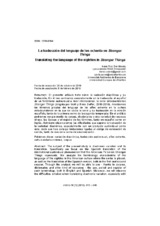Mostrar el registro sencillo del ítem
La traducción del lenguaje de los ochenta en Stranger Things
| dc.contributor.author | Ruiz San Miguel, Irene | |
| dc.contributor.author | Pérez Fernández, Lucila María | |
| dc.date.accessioned | 2020-02-05T10:08:34Z | |
| dc.date.available | 2020-02-05T10:08:34Z | |
| dc.date.issued | 2019 | |
| dc.identifier.issn | 1579-9794 | |
| dc.identifier.uri | http://hdl.handle.net/10396/19480 | |
| dc.description.abstract | El presente artículo trata sobre la variación diacrónica y su traducción. En él nos centramos concretamente en la traducción al español de un fenómeno audiovisual a nivel internacional, la serie estadounidense Stranger Things (dirigida por Matt y Ross Duffer, 2016-2019). Analizamos los términos propios del lenguaje de los años ochenta en la cultura estadounidense en la que se ubica la serie y su traducción en la versión española, tanto de la primera como de la segunda temporada. En el análisis podremos ver por medio de corpus, diccionarios y otra variedad de recursos el uso, las épocas y el registro de los términos, tanto en español como en inglés. Asimismo observaremos las dificultades que supone la traducción de la variedad diacrónica, especialmente con un producto audiovisual como este, dado que trae consigo limitaciones ligadas al código de colocación de sonido, tanto de isocronía como de sincronización | es_ES |
| dc.description.abstract | The subject of the present study is diachronic variation and its translation. Specifically we focus on the Spanish translation of the international audiovisual phenomenon that the American TV series Stranger Things represents. We analyze the terminology characteristic of the language of the eighties in the American culture where the series is placed, as well as the translation of the Spanish version, both in the first and second season. Through the analysis we will be able to see - thanks to corpora, dictionaries and other kind of resources - the use, period and register of such terminology, both in English and Spanish. Moreover, we will observe the difficulties entailed when translating diachronic variation, especially with an audiovisual product like this one, since it involves restrictions related to sound code, both isochrony and phonetic synchronization | es_ES |
| dc.format.mimetype | application/pdf | es_ES |
| dc.language.iso | spa | es_ES |
| dc.publisher | UCOPress | es_ES |
| dc.rights | https://creativecommons.org/licenses/by-nc-nd/4.0/ | es_ES |
| dc.source | Hikma 18(1), 315-345 (2019) | es_ES |
| dc.subject | Variación diacrónica | es_ES |
| dc.subject | Traducción audiovisual | es_ES |
| dc.subject | Cultura estadounidense | es_ES |
| dc.subject | Corpus | es_ES |
| dc.subject | Años ochenta | es_ES |
| dc.subject | Diachronic variation | es_ES |
| dc.subject | Audiovisual translation | es_ES |
| dc.subject | Eighties | es_ES |
| dc.subject | American culture | es_ES |
| dc.subject | Corpora | es_ES |
| dc.title | La traducción del lenguaje de los ochenta en Stranger Things | es_ES |
| dc.title.alternative | Translating the language of the eighties in Stranger Things | es_ES |
| dc.type | info:eu-repo/semantics/article | es_ES |
| dc.relation.publisherversion | https://www.uco.es/ucopress/ojs/index.php/hikma/index | es_ES |
| dc.rights.accessRights | info:eu-repo/semantics/openAccess | es_ES |

